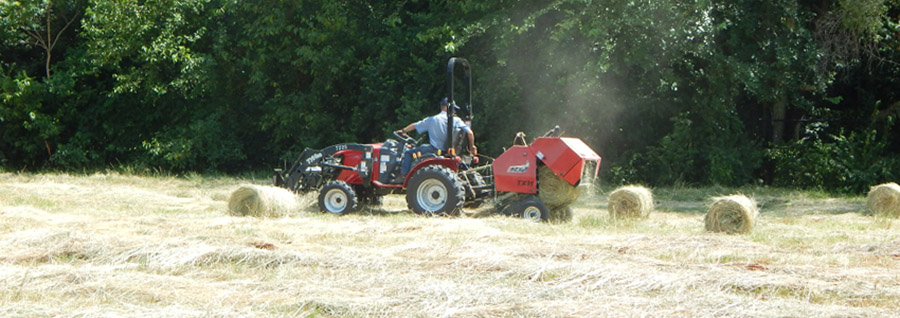Calculating Hay Yields

“How much hay can I expect to get from my ‘x’ number of acres?”
One of the most frequent questions we hear from our customers who are considering making the jump to haying independence is, “How much hay can I expect to get from my ‘x’ number of acres?” While we wish there were an easy answer to this question, there just isn’t. Unfortunately, the calculation of hay yields depends upon so many varying factors, that a single answer is just not possible to provide.
Even an average rule of thumb can vary widely by region, soil, and type of hay. For us here in the Midwest, a mixed grass/legume hay can yield anywhere from one to five tons per acre for a full season. In our mixed hay field, on good soils, we plan on four tons per acre, with half or more of that in the first cutting and the remainder in second, third, and sometimes even fourth cuttings. With an average bale weight of around 40 pounds (with our Abbriata small square baler or any of our mini round balers), that’s 100 bales to the acre for a first cutting.
Our farm aside, we can offer some guidelines to consider when trying to predict the productivity of your hay fields.
Here are some of the factors that affect hay yields or the calculation of them:
- The length of the growing season where you are located. Shorter growing seasons mean fewer opportunities for hay cuttings. While in an average season, growers in the southern United States can generally expect to cut hay 4 maybe even 5 times a year, those in the northern US might be lucky to get 2.
- The types of forage grown. As a general rule, perennial grasses like timothy and fescue generate higher yields while legumes like alfalfa and clover produce a lower yield. However, the choice of forage should not be based solely on yield since legumes tend to measure higher on the Relative Forage Quality scale which ranks nutritional value. In most cases, quantity should not be heralded over quality.
- The fertilization program in use. Hay tends to grow best in soils that are high in organic matter and contain adequate amounts of nitrogen, phosphorus and potassium. The needed amounts of these nutrients can be controlled through proper fertilization or crop variation/rotation. The latter can be achieved by either planting nitrogen-enriching legumes alongside grasses or by rotating seasons that each is planted.
- The timing and number of cuttings. A pasture’s yield should be calculated based on an entire season, or for even more accuracy, multiple seasons. The amount of hay produced at each cutting can vary dependent upon weather conditions, plant stage when cut, and species planted. The best yield calculations involve finding an average yield of many cuttings over several seasons.
Basically, the best way to determine the yield capacity of a hay pasture is to get out there and bale it. Though some of the factors affecting yield are out of the producer’s control — like weather — many others — like species and fertilization – can be tweaked over the course of multiple seasons to increase productivity. Though there is no easy answer to the question, “How much hay can I expect to get from my ‘x’ number of acres?”, there are simple steps you can take to keep your hay acreage producing at the highest levels possible. Happy baling!!!!
Recent Posts
-
Best Front Loader Attachments for Your Kubota BX Series Tractor
If you own a Kubota BX-series compact tractor, you already know it’s a versatile machine — but p …Dec 30th 2025 -
Boost Pine Straw Production Efficiency with Ibex Mini Round Balers
At Tractor Tools Direct, we're known for our high-quality hay equipment tailored for small farms …Dec 8th 2025 -
How to Winterize Your Tractor: Essential Maintenance Tips to Protect Your Investment
Farm equipment is one of the most valuable investments a farmer can make. At Tractor Tools Direc …Dec 1st 2025




